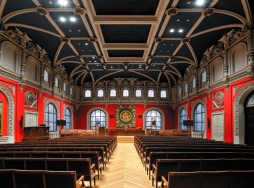Further acknowledgement for the refurbishment of Zaragoza University’s Assembly Hall
The building was designed in the nineteenth century by Ricardo Magdalena, the architect whose name the prize bears

FCC's refurbishment of the building housing the Zaragoza University Assembly Hall has won further acknowledgement in the form of an honourable mention from the judges of the Thirty-first Ricardo Magdalena Architecture Award. The refurbishment was designed by architects Luis Franco and Mariano Pemán.
The building, which dates back to 1895, is a fine representative of the historicist trend in vogue in architecture in the late nineteenth century, a style that drew its inspiration from Aragonese Renaissance palaces. The building used to be home to the university's School of Medicine and Science, and the four seated statues in the porch accordingly portray important doctors and scientists: Miguel Servet, Andrés Piquer, Ignacio Jordán de Asso and Fausto de Elhuyar.
The building has a rectangular floor plan with a great central courtyard. Some of the more interesting features of the building's construction are the outer walls made of facing brick, the use of a metal structure with decorative details on the outer face and the rough-set stonework in the basements.
The porch on the main façade is made of stone, designed in the shape of a triumphal arch with a pediment across the top. The four seated statues rest against the porch's pilasters.
The building is regarded as Ricardo Magdalena's masterwork and as the place where the city's regionalistic architecture got its start.








